Topic letter 10
Situational Coaching
1. Introduction
The word coaching has unfortunately become a container word referring to very divergent activities and ways of working. This article is an attempt to offer a frame of reference in which a number of different forms of coaching can be placed and related each other. This article is based on the use of two basic dimensions which form together effective behavior. On the one side we see competences and on the other side a frame of reference. A competence is defined here as the whole of knowledge and skills, embedded in attitude, that gives a person the ability to perform in a role. The frame of reference is whole of mental models that are used in a role. The frame of reference includes all facets of giving meaning, such as making problem definitions, analyzing possible causes and the models on basis of which choices for solution directions are made.
2. Basic question
The basic question of a coach is thus if the lack of effectiveness is caused by a lack of competences and/or by a lack of an appropriate frame of reference. These two dimensions are independent of each other and form a matrix in which the levels of maturity in performing a role can be defined. This matrix describes 4 levels of development in a role, which are explained here.
| competentence | strong |
B. the employee has the competences to solve problems of this kind, but is confused about how to tackle the present one |
D. the employee has a good understanding of the problem and has the competences can help him to do so |
| weak |
A. the employee hasn’t got the suitable competences to solve a problem, nor does he have an overview of the problem in it’s context |
C. the employee has a good understanding of the problem and how to solve it, but misses the competences to do so |
|
| Matrix of levels of role maturity |
weak | strong | |
Development level A: "I don’t know how to start".
This situation occurs when an employee gets a new role, or if role has recently changed a lot. The employee has nor the desired set of competences, nor an in-depth frame of reference. Not clear is how to tackle a problem, nor which indicators are relevant in choosing a treatment. The whole field still must be explored.
Development level B: “I should be able to do it, but I miss the overview at the moment”
This situation occurs when an employee has successfully done a similar job at an other location, or if the role is known, but the circumstances have changed dramatically. The one to one repetition of old formulas of success don’t work anymore. The employee needs to understand the new context of working, needs to learn to read/understand the new reality. Refreshment of the frame of reference is needed. Sometimes, when everything is understood again, new competences might be needed, but that is not the first concern.
Development level C: “I can define what the problem is here and how to solve it, but I miss the competences to do so”.
This situation occurs when an employee is able to analyse the situation, to define what the problem is and to decide what suitable options are to solve the problem. However he misses the competences to do so or doesn’t know yet how to use the tools which are needed. To delegate the problem solving to another person might be a solution. If solving problems like these are part of the role, learning how to use the tools and gaining the necessary competences will be a better option.
Development level D: “I think that I can handle the situations and the problems concerned, but I would like to check the way I’m working and thinking.
This situation is the target situation of all coaching activities. The employee understand the situation, so his frame of reference is suitable to solve the major topics. Besides that, he has the competences to act in an effective way. A role is never static, the system and the context in which the systems functions, are constantly changing. More and more especially managers prefer to have a coach who from time to time helps to reflect with a coach who hasn’t got any interest in that area.
3. Two basic dimensions of coaching
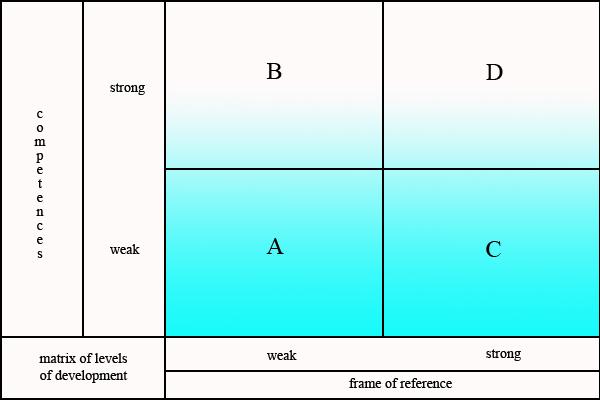
Each development level has a most appropriate manner of coaching. The two dimensions which together characterize the development level, indicate also the two basic dimensions of coaching.
The first dimension, the lack of competences, asks for learning those competences. In the graph this has been indicated with a blue color. Learning a coachee competences always means that the coach must have at least a good idea about the needed competences and frequently also must have the competences himself. In that case, the coach must be an expert in that particular field in order to transfer these competences. The relationship between the coach and the coachee easily becomes a master – pupil relation. The coach gives and the coachee receives. Coaches who are not an expert in a particular field, have too little to offer to the coachee if the problem can be reduced to a lack of competences. Fortunately for coaches, there are a lot of general roles, so also a lot of general competences, like leadership. Coaches with a general background and a lot of experience usually have these competences. If a coachee wants to improve in a particular field of expertise (e.g. marketing), he should use a coach who also has worked in that particular field.

Adapting the frame of reference asks for completely different other angle. The coaching now focuses on the way the coachee observes the reality, on the assumptions and mental models which underpin the acting in the role. Creating consciousness is here the issue. People are able to change their frame of reference, if they understand what their frame of reference is, how other frames of reference on the same subject look like and if they understand that looking at it in an other way can be much more effective. The first step, becoming aware of the own frame of reference, sometimes is called "unfreezing". The main activity of the coach is to ask the coachee to reflect aloud about and to give words to the mostly implicit mental framework. This asks for a naïve reflection, empathy and sensitivity from the coach. The coach helps to make the frame of reference explicit and to check this frame all the time. Inconsistencies and blind spots become visible. Incidentally the coachee can adopt pieces of the frame of reference of coach, especially if the coach and the coachee are able to “speak the same language”. In general it is better if the coachee reconstructs his own frame of reference in his own way. By doing that he incorporates entirely his own thinking. New parts of the mental framework are then integrated in the entire framework. A coach can become counterproductive if he wants to if he uses an expert role at this point, because he will then try to implant own mental models in a different frame of reference. Concepts which are imposed to the conscience of another one, will be ricocheted just like implanted organs in a strange body. The coach might give suggestions as long as the coachee says "of course, why haven’t I thought about that in this way myself!" (eye opener). In these cases the coach has the confirmation that the coachee incorporates the new thoughts directly in his own frame of reference. In the matrix, this coaching activity is presented by the yellow color.
4. Two basic dimensions, four coaching styles
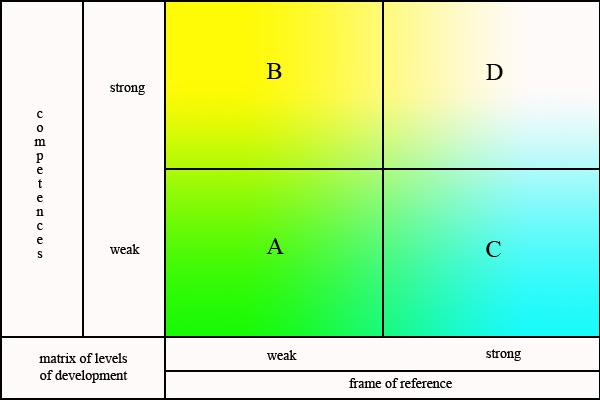
The two basic dimensions of coaching meet each other strongly in quadrant A and only weak in quadrant D. Quadrant B is dominated by the focus on competencies, quadrant C by the focus on the frame of reference. On the basis of this diagram we can distinguish 4 different learning paths for a coachee and connected to that 4 coaching styles for the coach. These coaching styles are called:
- the step from A to D, the learning of competencies and the obtaining of an appropriate frame of reference, is stimulated by the coaching style To Mentor.
- 2. the step from C to D, learning competencies, is stimulated by the coaching style To Train.
- 3. the step from B to D, obtaining an appropriate frame of reference, refers to coaching style To Reflect.
- 4. optimizing D, to actualize and review the correct mix of competencies and frame of reference are, is called the coaching style To Philosophize.
5. Further exploration of the coaching styles.
1. To Mentor, from development level A to D.
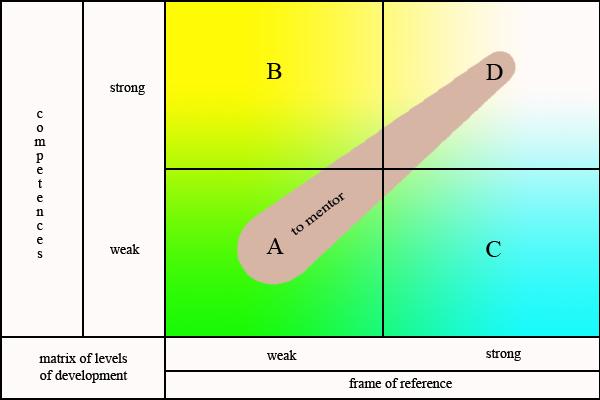
The coachee has a new or strongly changed role. That asks for an exploration of that role and of the area in which the role is being done. The frame of reference is still blanc and hardly defined.. There is hardly any notion of which information is important and which not. Also the view on which competencies are needed to solve each of the problems, must still be developed. The coaching style To Mentor is characterized as guiding and steering. The coach takes the coachee by the hand and helps him to explore the area of the role. The coach will ask questions and gives clue to gain a deeper insight. Helpful sets of questions are the STAR analysis (Situation, Task, Activity and Result) or the CATWOE (Customer, Actor, Transformation process, Weltanschauung, Owner and Environmental constraints). In order to gain the missing competencies, a learning route is defined. The coach as a mentor looks like the archetype of the guild master.
2. To Reflect, from development level B to D.

If the coachee has the necessary competencies to fulfill a role and nevertheless experiences serious problems, the focus during the coaching will be on the frame of reference of the coachee. The interpretation of the role in the work system is examined and is clarified. This research aims among other things at what the aim is of the work system, which added value is expected of the role and with which (internal and external) dynamics must be taken into account. Also the match between the coachee and the role are reviewed. What offers the role to the coachee and what wants the coachee to get out of of this role? A last subject is the way in which the coachee interprets his tasks. Which problem definitions are used and which standards and values can be detected underneath. After this research, the problem is faced again, and the coachee is asked whether he adjusted his perspective on the whole matter. The coach can promote this process of re-thinking and re-evaluating by introducing hypotheses which are reviewed by the coachee. The coachee learns step by step to "read" the reality in several different ways.
3. To Train, from development level C to D.
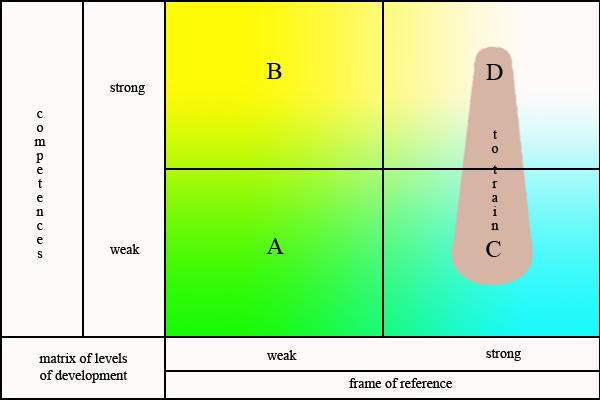
A coachee at this point of development, has a reasonable good picture of his work system and its context, his role, the specific tasks and the needed competences and tools to solve problems, but faces the fact that he is not yet competent to do the job. What he needs is support, instruction and training (on the job) as a way of obtaining these exercises competencies. The coaching can possibly take place on office of the coachee, to reinforce the character of training on the job. The coach needs to have some expertise in that area and if he doesn’t master the competences himself, he knows who can teach the coachee in this. The coach not seldom acts here as a role model for the coachee, illustrating the desired behavior.
4. To Philosophize, optimizing level D.
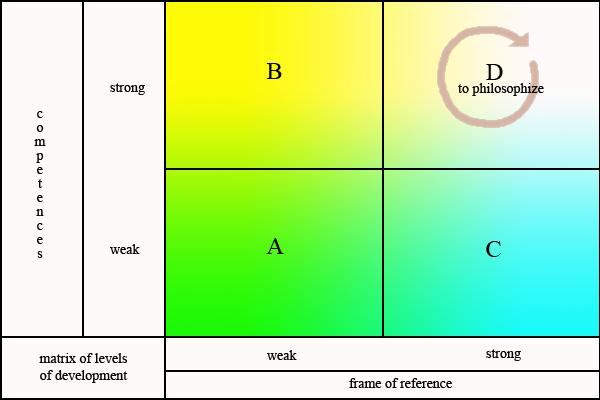
Even those who function well, can feel the need to reflect from time to time on their way of working. Some considerations are not easily expressed to colleagues without influencing the work situation or the work relation. The saying "it's lonely at the top" is referring to this subject. Discussing topics with a coach who has no personal interest, can have the function of reconsidering decisions, preparing discussions and checking the ins and outs of a plan. “Do I oversee everything clear and am I not forgetting valuable information?” If considerations like these are formulated, they become also more tangible and by doing that more easy to handle. Especially executive coaching is a growing phenomenon in this area. The coaching style To Philosophize asks for an empty spirit. It is a form of unprejudiced meeting of each other. To Philosophize is as a walk through the frame of reference of the coachee. The coach adds nothing, refrains from everything that might associate him with an expert, and tries to raise only the awareness on topics, by which the role and the tasks are lighted in new ways.
6. A case
A marketing manager comes with his concern that he has all the symptoms of an approaching burn-out. He wakes up too early every morning, get too less sleeps and he can concentrate only poorly on his work. He makes long working days. The boss however is very satisfied about its performances.
The first analysis learns that the coachee has a poor understanding about the nature of his work. He tackles everything with the same enthusiasm and finds it difficult to postpone work. There seems to be no differentiation in importance, so he reacts especially to urgency and hardly dares to give no as an answer. If asked he says that he knows the principles of time management, but a second check learns them that he applies those principles only scarcely.
A first conclusion is that both the frame of reference (nature of the work) and the competencies (time management, assertiveness) are below standard. In this model, he has a development level A. In consultation it is decided to give attention to both clarifying the targets (to learn know the relative importance of tasks, from A to C) and to the application of the principles of time management (competencies, from A to B). The coach decides to are alternatively reflect (what are the 5 most important tasks) and to train (read these two books and make an action plan).
After a while the targets in the work seems to be clear, the tasks are arranged on the basis of priority and the days are much more structured. The coachee turns out to be a diligent student. He forces himself to much more structure at work and he produces more output.. The quantity working hours however does not reduce. Although he has much more pleasure at work, the chances that he will get a burnout have not decreased.
Since the competencies seem to be in order, more attention is given to the role of the work in the live of the coachee and to his tendency always to please the manager in the company. This aspect of coaching can be seen as working on the frame of reference, the step from B to D. The coachee slowly becomes aware of an old and steady pattern in live, an urge to constantly prove himself and the tendency to pleasure authority characters. From the moment that he learns to discover what he really wants himself, he finds the energy to direct the work more the way he wants it. On the end of the route, when everything seems to go according plan, suddenly a new question arises, "am I doing the work that is really appropriate for me?". Together the coach and the coachee decide to spend some time on this question (intervention on level D).
7. A final word
The model situational coaching learns that a coaching style which is very appropriate for one type of question or for one developmental level, can be complete inadequate for questions from another level. The coaching style To Reflect, in which the coach uses his expert role, can be completely counterproductive if a coachee has a need connected to an inadequate frame of reference. The coachee might even ask “tell me what to do” but if the coachee has the competences to solve the problem, a coach should according to this model refrain from giving advices. Giving advices might satisfy the coachee for the short term, but will never help him on the long run, because he misses the frame of reference to incorporate the advice. By giving advices to a coachee who needs only reflection, the coach keeps the coachee in the wrong position ánd reinforces future depending on the coach. provides coach on that is own ideas in the form of recommendations imposes to the coachee.
Since coaching more and more is seen as a tool of development, the need for appropriate coaching increases. In the everyday practise, the need for the style To Philosophise is emerging especially, due to the changing value that is connected to coaching. In the old days, the need for coaching was seen as a sign of weakness. If one had a coach, he was not able to solve his own problems. Nowadays it is almost the other way around. Not having a coach is seen as missing opportunities to learn. Executive coaching has become an integrated component of the work process, a sort of mental bath that is taken from time to time in order to keep a fresh look at work.
Juni Daalmans
Daalmans Organizational Development
March, 2007